Cycle News Staff | September 30, 2021
These are the two hottest ADV bikes on the market. But are they comparable? We took them for a month to find out.
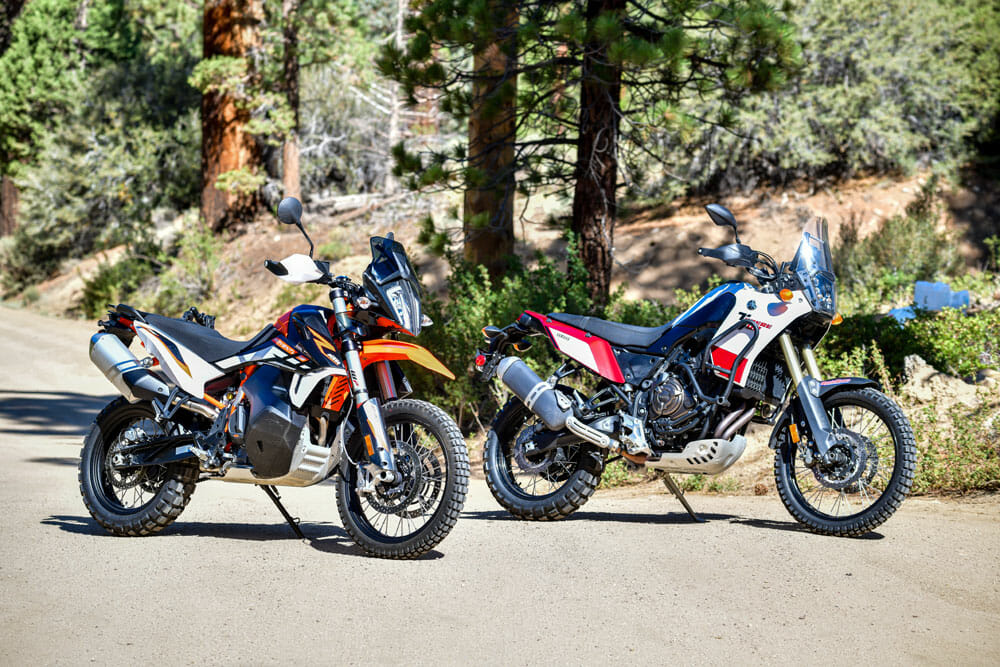 There’s over $4000 of difference here. Yes, that’s a lot, but it depends on what you value in your ADV steed.
There’s over $4000 of difference here. Yes, that’s a lot, but it depends on what you value in your ADV steed.
By Rennie Scaysbrook, Sean Finley, Jesse Ziegler | Photography by Kit Palmer
Adventure riding is the hottest ticket in town for manufacturers and it’s been this way for a while now. The pandemic has only heightened the excitement around the class and put these bikes under an even greater spotlight.
We’ve tested the KTM 890 Adventure R and the Yamaha Tenere 700 extensively in the past, so if you’d like to read up on those two individually, please check out the links. This test between the two is a three-way opinion piece with Sean Finley, Jesse Ziegler and Rennie Scaysbrook, each with varying points of view as to what makes the ideal ADV steed. Did they get it right? Read on to find out.
But first, we must note that new Continental TKC 80 tires were installed on both bikes. These are a good all-around tire for street and off-road riding and come standard on the KTM 890 Adventure.
Plus, we kept an eye on fuel mileage. Both bikes averaged 45 and 50 mpg.
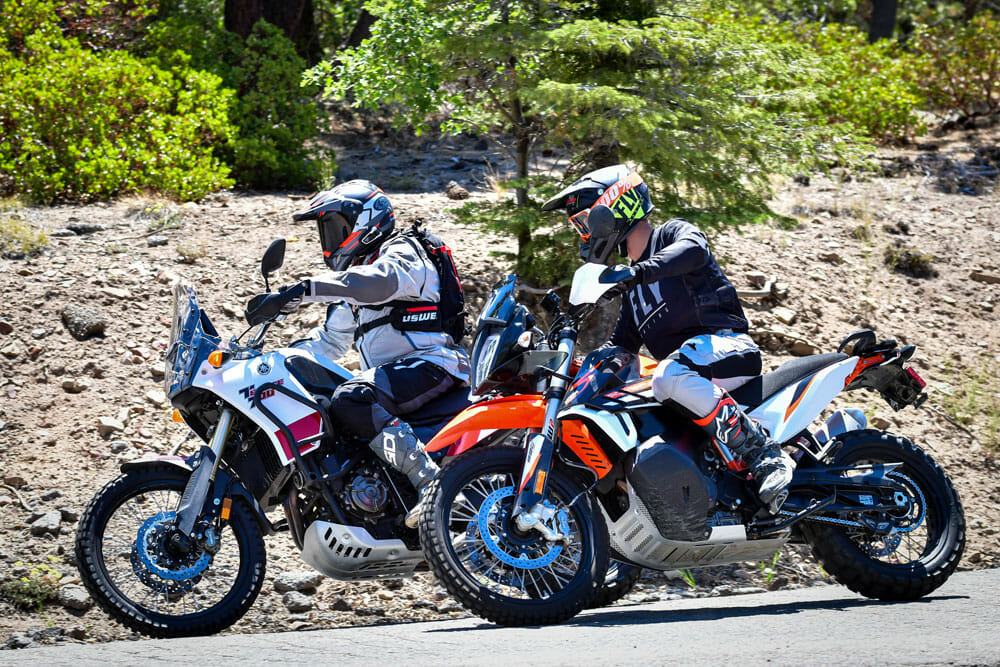 On the road, there’s no comparison. The KTM’s motor annihilates the Yamaha. But the Yamaha has better long-distance comfort.
On the road, there’s no comparison. The KTM’s motor annihilates the Yamaha. But the Yamaha has better long-distance comfort.
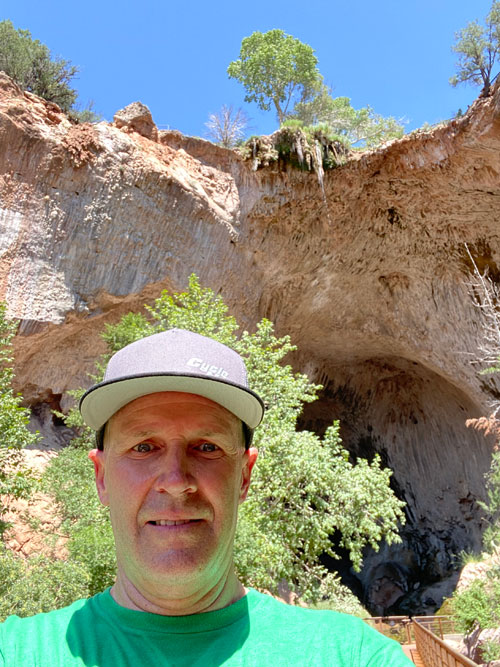
VIDEO | KTM 890 Adventure R vs Yamaha Tenere 700
Sean Finley
- Age: 52
- Height: 5’ 10”
- Weight: 165 lbs.
I have been riding motorcycles for most of my life both on the dirt and street. I spent much of my 20s, 30s and early 40s riding or racing at the local motocross tracks nearly every weekend and riding in the desert with my friends and family. I also did a fair share of West Coast GPs and raced a few GNCCs. I have slowly transitioned to mostly riding off-road and ADV bikes to explore new terrain. On the ADV side, I owned a Suzuki V-Strom for a while, used mostly for So Cal commuting, and owned a KTM 1190 and a 2017 Honda Africa Twin. I have ridden most of the big and small ADV bikes over the past 15 years, including spending a week in Europe on a BMW GS 1250 a couple of years ago.
My current ideal ADV bike is a big dirt bike that is good on the highway but still allows me to explore semi-challenging off-road terrain around my home in Prescott, Arizona. If I end up on a dirt road that gets rocky or turns into a trail, I want to be able to keep going. In my opinion, the KTM 890 Adventure R and Yamaha Tenere 700 are currently the two best bikes for this type of riding, so this comparison was perfect to help me decide which bike is best for my current taste in ADV riding.
Yamaha and KTM approached this small displacement ADV category from different angles. The Yamaha Tenere is a relatively simple bike with limited electronic rider aids (just ABS with a simple button to turn it on/off) while the KTM includes a wide range of maps for the engine performance, traction control, and a more sophisticated ABS system.
The Yamaha includes a cable-actuated throttle while the KTM is fly-by-wire, and yes, that does feel different. The KTM has a claimed 100 horsepower with 75 lb-ft torque while the Yamaha has 72 horsepower with 50 lb-ft torque. With that extra power, the KTM will run away from the Yamaha on the road. All this tech on the KTM also comes with a hefty MSRP of $14,199 versus $9999 for the Yamaha.
The big questions for me and anybody considering these two options is which one is the better bike and is the KTM worth over $4000 more? Unfortunately, my answer is not clear cut. In terms of pure performance on the street, the KTM has an advantage. The additional power, better brakes and predictable chassis makes it an incredibly fun street bike. And the optional quickshifter and cruise control ($350 to get the dealer to unlock these features) widen that gap.
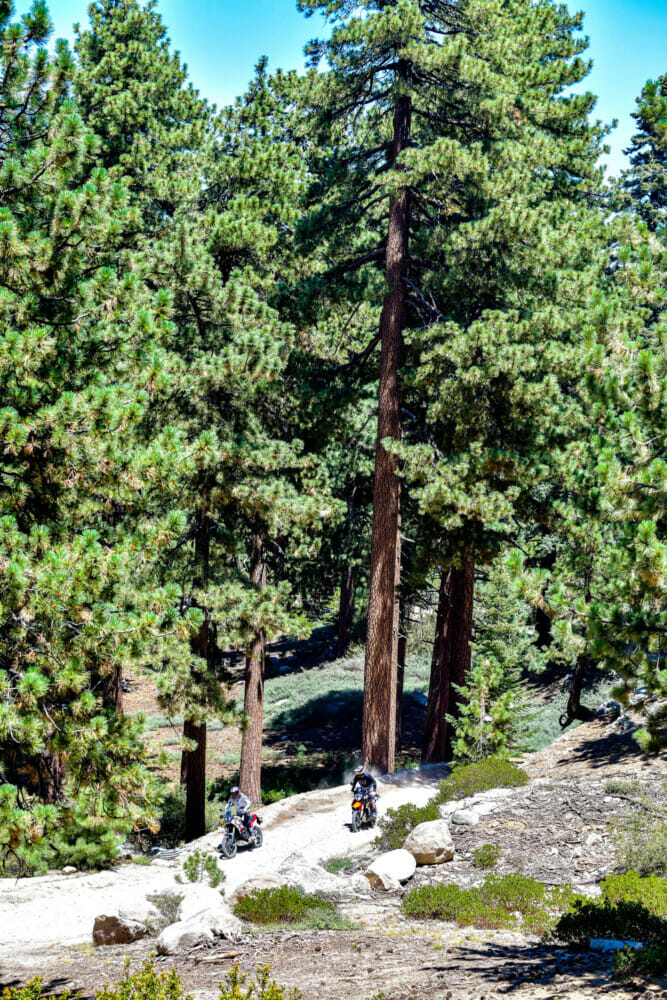 Big Bear on a sunny summer morning with two of the best ADV bikes around. It doesn’t get much better.
Big Bear on a sunny summer morning with two of the best ADV bikes around. It doesn’t get much better.
If you have never ridden a bike with a quickshifter, you will be blown away by how much fun it is to bang through the gears without touching the clutch, and it is almost as much fun to use it downshifting into corners as well. And the cruise control is also a nice feature for long road sections.
The Tenere 700 is much better than any dual-sport or off-road bike on the road but compared to the KTM, it is basically a big dirt bike that will be fun for exploring, but it does not have the kind of power that will get you really excited. If you don’t compare it to the KTM, or are not into going fast on the road, then the Yamaha will be fine. The motor is fun and smooth.
Riding the bikes off-road, the gap becomes a little narrower for me. The Tenere motor is ultra-smooth and does not require a swap in engine maps (which it doesn’t have, anyway) to tame it down in the dirt. And a quick push of a button turns off the traction control while the KTM requires coming to a stop and thumbing through the maps and ABS on/off option. If you are transitioning from street to dirt a lot, it is perfectly fine to leave the ABS map in the more off-road friendly settings and this is what I did.
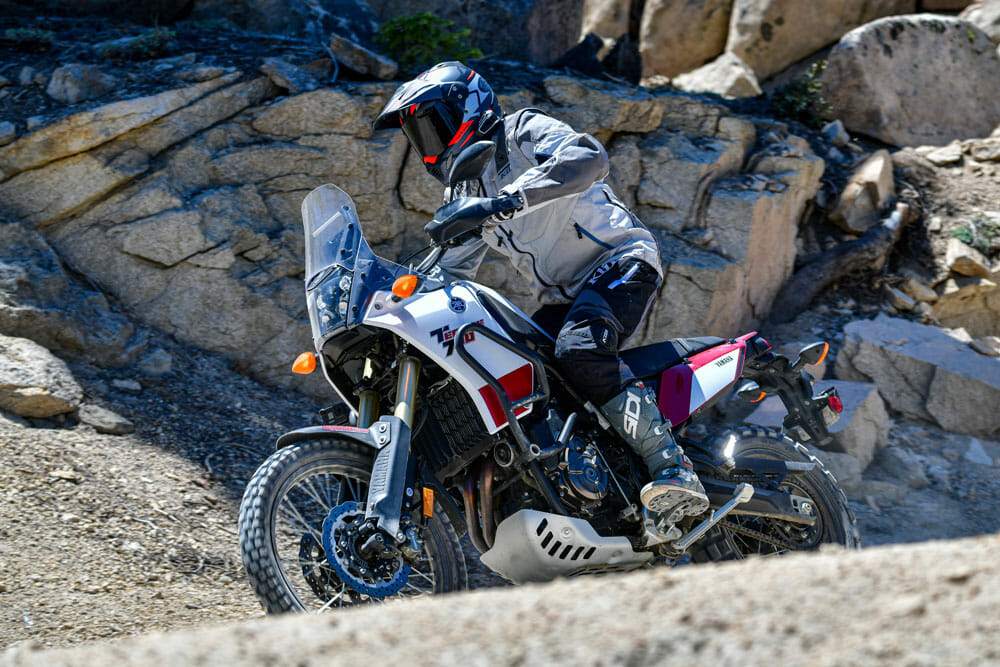 Long, tall and rangy, the Tenere 700 is the bike if you’re a bigger rider. The weight is carried quite high, which can be a problem for some.
Long, tall and rangy, the Tenere 700 is the bike if you’re a bigger rider. The weight is carried quite high, which can be a problem for some.
As far as the chassis feel off-road, the 890 Adventure carries the fuel much lower, and this lower center of gravity is noticeable compared to the Tenere but not as much as you might think. The Tenere caries 1.1 gallons less fuel and is 20 pounds lighter with full tanks (about 6.4 pounds of that coming from less fuel onboard). But the tradeoff on the lower fuel tank on the KTM is that the bike is really wide down low, and it makes the bike feel bulky, especially in some narrow trail conditions.
Both bikes are very fun and capable in the dirt and can take on pretty technical terrain. The suspension settings and slightly more travel on the KTM help it work a little better if you really push the pace, as the Yamaha suspension is a little softer, which is great for slower speeds, but you will find it bottoms sooner. But in terms of fun and capability, they are close.
Which one would I buy? Since the two bikes are relatively close in performance in the dirt, I could be happy with both bikes and keeping $4000 + in my bank account tips the scales towards the Yamaha Tenere. But if money is not part of the equation or the street performance is more important to you, then the KTM 890 Adventure R is the winner.
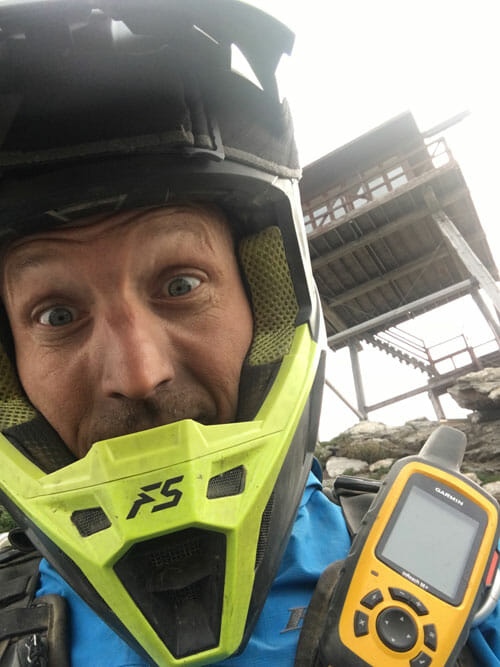 Jesse Ziegler
Jesse Ziegler
- Age: 44
- Height: 5’10”
- Weight: 180 lbs.
I distinctly remember running into my dad’s truck numerous times on my JR50, my first motorcycle. Since then, I’ve moved away from hitting stationary objects (mostly) with bikes and onto the trails and tracks and backroads of the world. I’ve ridden off-road my entire life, discovered competitive motocross in my early 20s and have subsequently dedicated my career to the motorcycle industry. As a member of the media, I’ve evaluated off-road, MX and ADV machinery around the world, and raced as much as possible along the way. From California track days to Rocky Mountain single-track trips, I’ve tried to do it all. ADV bikes are all-access machines, and I’ve tested or owned just about every one available in recent history. From BMW’s rowdy HP2 and KTM’s hefty 950 Super Enduro to Harley-Davidson’s surprising Pan America, I can’t think of an ADV machine I haven’t ridden.
This is a comparison that everyone wants, but nobody really needs. The results are in on the dealership floor before you roll into the dirt (hopefully that’s where you’re riding these bikes). Why? Because these bikes are in completely different leagues and the prices/specs reflect that, rather obviously.
Still, they are considered very closely as the top two choices for many a midsize ADV buyer. So, here’s the Ziegler truth about what is up with these two whips.
First, the KTM is a premium offering, and its price shows that. For the extra approximately $5k, you get upgrades everywhere. From the information display to the engine performance, suspension capabilities, brakes, quickshifter and more, you can easily justify the KTM purchase as “you get what you pay for.” And it’s true.
The bike is fantastic at being an ADV assault weapon. Rally mode gives you massive tunability into electronic aids that make them hard to argue against. Haters here are simply too intimidated/busy to learn the buttons because every traction and braking system on the KTM 890 works, and works well.
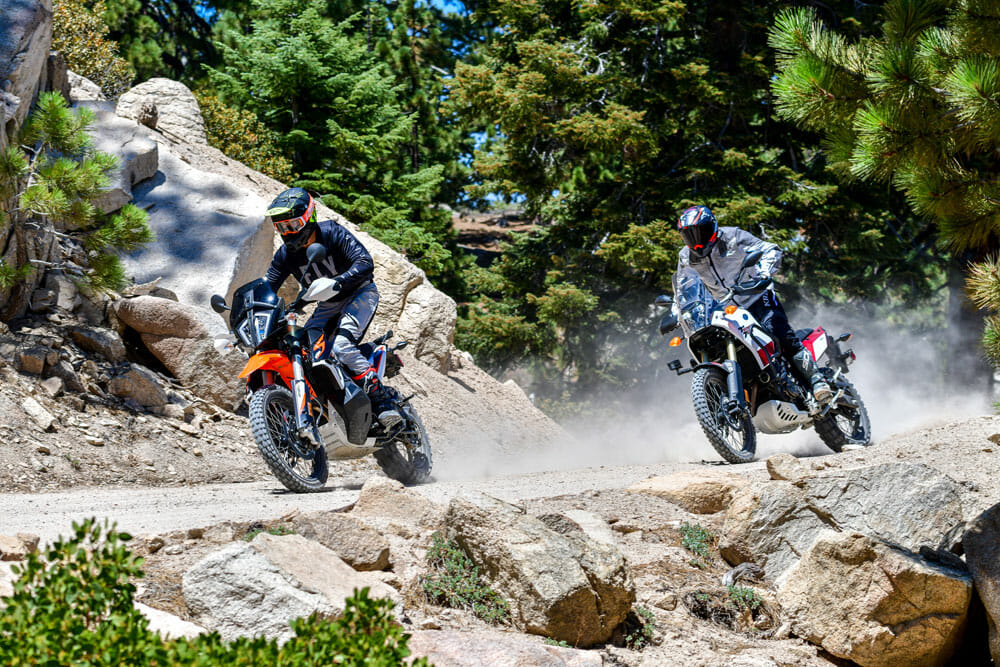
The KTM can out-mileage just about anything comparable thanks to great fuel economy and capacity, and it can match the nimblest of ADV tools in the technical terrain due to fantastic weight distribution.
Pony up some more cash for Rally suspension and the bike can, and has, competed in serious off-road racing. So, if we’re keeping track here, it has the chops to go hard, and the technology on board to outperform just about anything across the board.
KTM’s 890 platform has matured from the 790’s early production woes of leaky shocks and smoking clutches. Now, it is a proven, durable tool that has a serious sport side looking to compete. It’s more hard-edged, less comfortable in the wind and sort of wants to ride pissed off all the time to really party. So, if that’s not for you…
So, why would you choose the Yamaha Tenere 700 in this matchup? Because you despise electronic intervention (even if it helps you), you want the best looking ADV machine available, and you really like not spending more than $10,000.
For this, the Yamaha is wonderful. This bike is under $10K—that still surprises me when I look at it. It provides a truly affordable platform to get off-the-grid with your riding, and it looks great doing it. I absolutely love the way the Yamaha Tenere 700 looks.
Now, the T7 cannot compete against the KTM 890 in very many performance areas, except price and the omission of menu items. And that should be okay to Tenere 700 buyers. They are not looking for menu items. They are looking for simplicity and a $10,000 price tag.
The Yamaha does fall short in braking performance, suspension capability and outright engine output, but it’s a smaller engine, so that makes sense. I can’t defend the other two shortcomings.
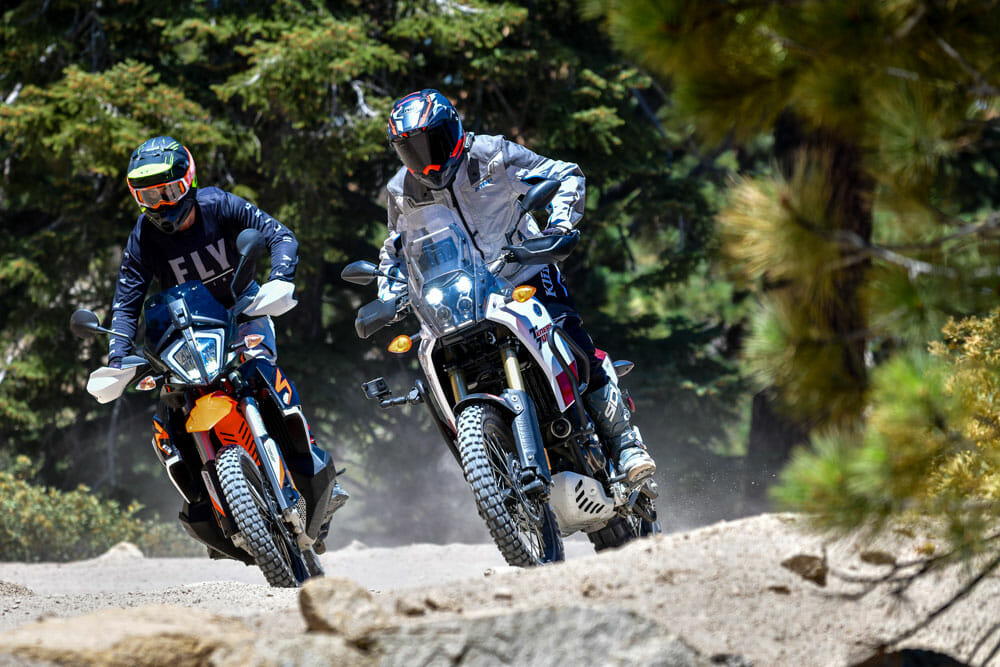
The beauty of the Yamaha CP3 motor is hard to hate. It is massively fun, smooth and torquey—perfect for a bike that doesn’t have traction control. The Tenere is also arguably more comfortable with a better gap from footpeg to seat and much better wind protection from its rally-inspired fairing/windscreen. For this, the Tenere is the good-looks leader and is the most comfortable on the road. However, it has a few chinks in its affordable/attractive armor as mentioned above. Plus, it desperately needs more fuel range, and the fuel that’s in it is high and heavy, making the seemingly simple and nimble bike surprisingly awkward if it starts to tip over.
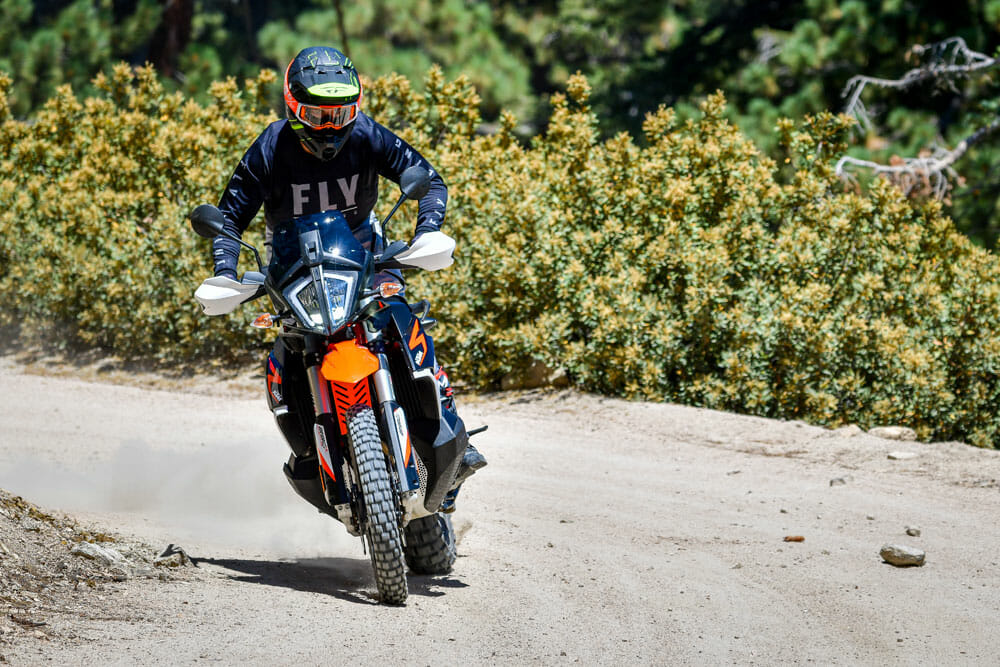 Rock out in Rally mode on the 890 and you can pretend you are Toby Price without the associated medical bills.
Rock out in Rally mode on the 890 and you can pretend you are Toby Price without the associated medical bills.
In summary if you’re shopping between these two bikes, the differences are clear. And the price difference is even clearer, matching those differences. You need to do most of the work deciding on who you are, and what you really want to ride.
For me, I’ve tasted the sweet extra performance the KTM is providing, and I’m not prepared to go back to not having it on the menu, so I’m taking the KTM here. But, if you’re not as performance-biased, are disinterested in the tech, and simply don’t want to spend the extra cash, the Yamaha is the clear way to go.
 Rennie Scaysbrook
Rennie Scaysbrook
- Age: 39
- Height: 6’1”
- Weight: 195 lbs
Riding has been as essential to my well-being as a solid pair of underpants. I started on my nana’s farm at four, first bike at five, started racing at eight, and have been at it ever since. I’ve ridden and raced all over the world, hold the all-time course record at the Pikes Peak International Hill Climb, and have a son that’s more mental on bikes than I am. Being the Cycle News Road Test Editor has given me access to just about every bike imaginable, including every ADV machine on the market. I spend more time on-road than off-road, but I still love to get off the hard stuff and onto the dusty stuff when time permits.
I don’t get out as often as I’d like on big ADV bikes, being that most of my riding is done on the street with sticky 17-inch tires underneath me. Still, I’ve done plenty of miles on both the T7 and the 890 both on- and off-road, and the answer to which I’d go for isn’t as clear as what I anticipated.
As Sean noted in his review, there’re plenty of arguments for the KTM. More cubes, way more electronics, and suspension tuned via Quinn Cody’s very sensitive ass means the 890 is more adept at really getting off the beaten track.
Having ridden lots of miles on the old 790 Adventure R, the difference between that and the 890 is bigger than you’d imagine. The 890’s extra cubes and stronger low-down torque make it a gem of a street bike, and the variable riding modes make the bike as mellow or mental as you like.
The placement of the fuel at the bottom of the motor is interesting in that it gives the 890 excellent low- and high-speed stability, but you’re constantly aware of the extra width. A few times I was worried I was going to bash straight through the tank (I wasn’t going to, obviously), but compared to the T7 you’re very aware the bike beneath you is bigger than it would normally be.
Get the 890 out on open trails and you’ve got close to the perfect big dirt bike, the electronics allowing you to slide and spin, and the chassis soaking up almost all your general stupidity. It’s a riding different style of riding compared to the T7, which is much more the traditional ADV machine but in no way less adept at the task.
I rode a T7 down the coast to the mountains outside Ensenada in Mexico last year and was shocked at just how good it was on some of the super gnarly sections my crew and I rode. Despite having the weight/fuel up top in the traditional place, this is less of a concern because the T7 is a much longer, taller steed to the KTM. Being 6’1” I was far more comfortable for long distances on the Yamaha, not just in overall bike size but also the comfort of the seat, which is a great pew for something straight off the showroom floor.
The T7’s motor is such a sweet little thing. It’s perfectly dialed for off-road riding but will get munched on the freeway by the faster KTM. Having no riding modes is no problem for me, and I never felt I was missing out while on the Yamaha with the KTM in front of me.
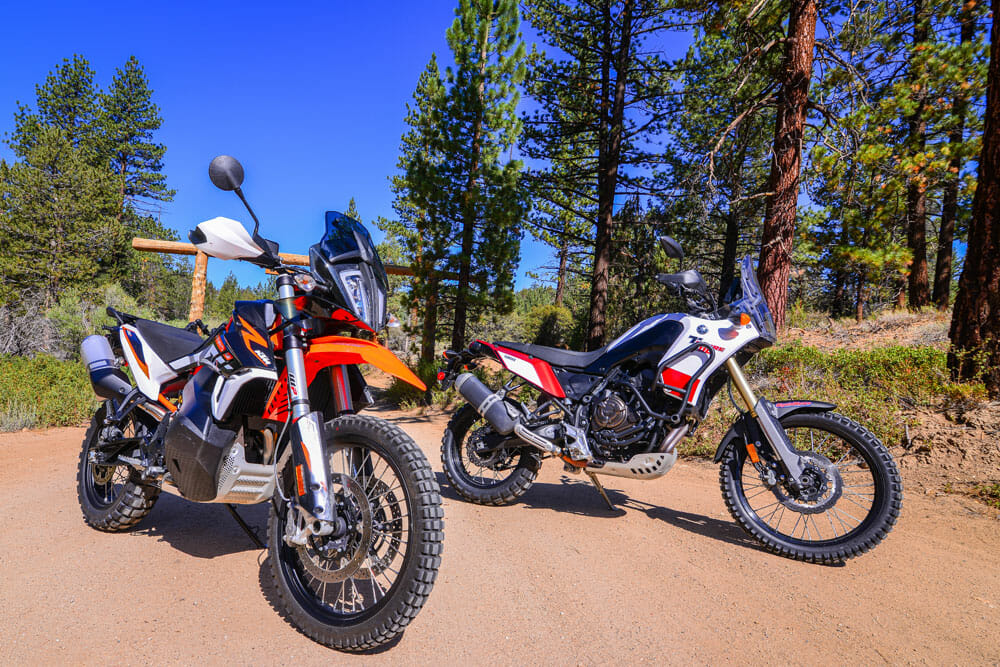 Jesse and Rennie went for the KTM, but Sean chose the Yamaha. Each bike has its good and bad points, and truth be told, they are both incredible bikes in their own right.
Jesse and Rennie went for the KTM, but Sean chose the Yamaha. Each bike has its good and bad points, and truth be told, they are both incredible bikes in their own right.
The Yamaha is, however, let down by suspension that isn’t anywhere near as good as the KTM and brakes that feel like they should be on a mountain bike, rather than an ADV machine. This is where the cost-cutting nature of the Yamaha shines through. Mind you, we try to test these bikes pretty hard, at which point things like this really start to show. If your riding is going to be on the mellow side, these Yamaha issues might not upset you as much as they did me.
If it were my money being thrown at a new steed, I would have to swing the way of the KTM, but only just. My argument being that by the time I’d spent the money upgrading the suspension and brakes, I’d be close to what the KTM cost, anyway. I am a little annoyed that you need to pay extra for a KTM dealer to unlock the various modes by simply plugging in a computer, but KTM has been doing this for years so it’s no surprise.
Having said that, I really love the T7. For the price, you get a stonking amount of bike for the money, and if you’re just out for a dirt road/rutty cruise and not planning on going rock hopping like you can with the KTM, the T7 is the one. CN
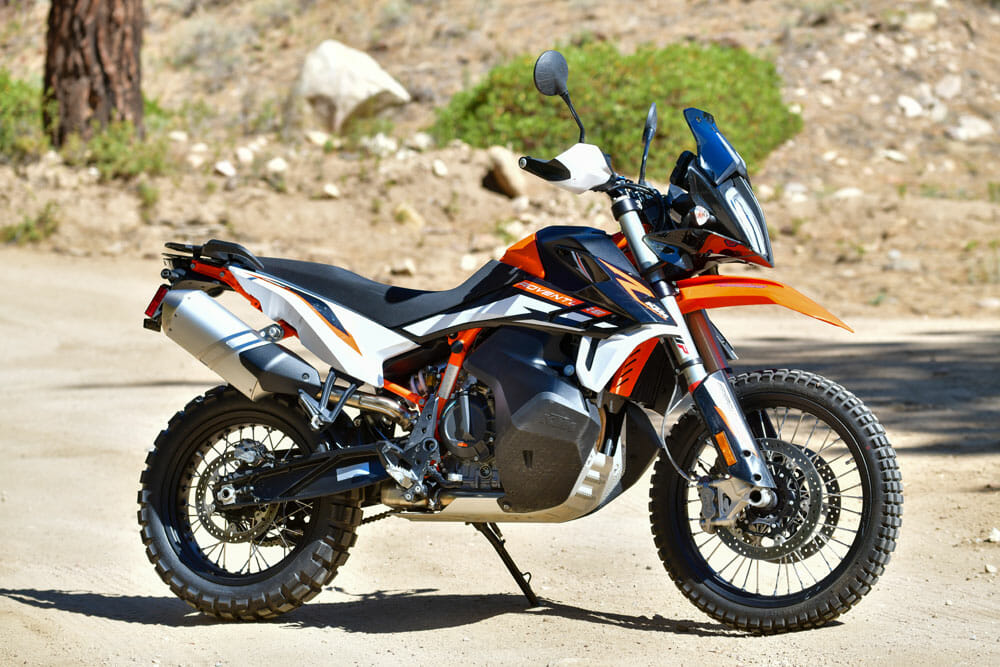
KTM 890 Adventure R Specifications
| MSRP: |
$14,199 |
| Engine: |
Parallel-Twin |
| Displacement: |
889cc |
| Bore x Stroke: |
90.7 x 68.8mm |
| Valvetrain: |
DOHC, 8 Valves |
| Fueling: |
EFI |
| Horsepower (Claimed): |
100 hp at 8000 rpm |
| Torque (Claimed): |
74 lb-ft at 6500 rpm |
| Transmission: |
6-Speed |
| Clutch: |
Pasc Assist-And-Slipper |
| Frame: |
Tubular Steel w/ Stressed Engine, Removeable Subframe |
| Handlebars: |
Tapered Aluminum |
| Front Suspension: |
WP Xplor, Coil Spring, Fully Adjustable |
| Rear Suspension: |
WP Xplor, Single Shock, Non-Linkage Fully Adjustable |
| Front-Wheel Travel: |
9.4 in. |
| Rear-Wheel Travel: |
9.4 in. |
| Front Brake: |
Radially Mounted 4-Piston Calipers, Dual 320mm Discs w/ ABS |
| Rear Brake: |
2-Piston Floating Caliper, 260mm Disc w/ ABS |
| Front Wheel / Tire: |
Spoked / 90/90-21 in. Continental TKC 80 |
| Rear Wheel / Tire: |
Spoked / 150/70-18 in. Continental TKC 80 |
| Rake: |
26.3/26.2° |
| Wheelbase: |
60.2 in. |
| Seat Height: |
34.6 in. |
| Fuel Capacity: |
5.3 gal. |
| Weight (Wet Weights, With Fuel): |
490 lbs. |
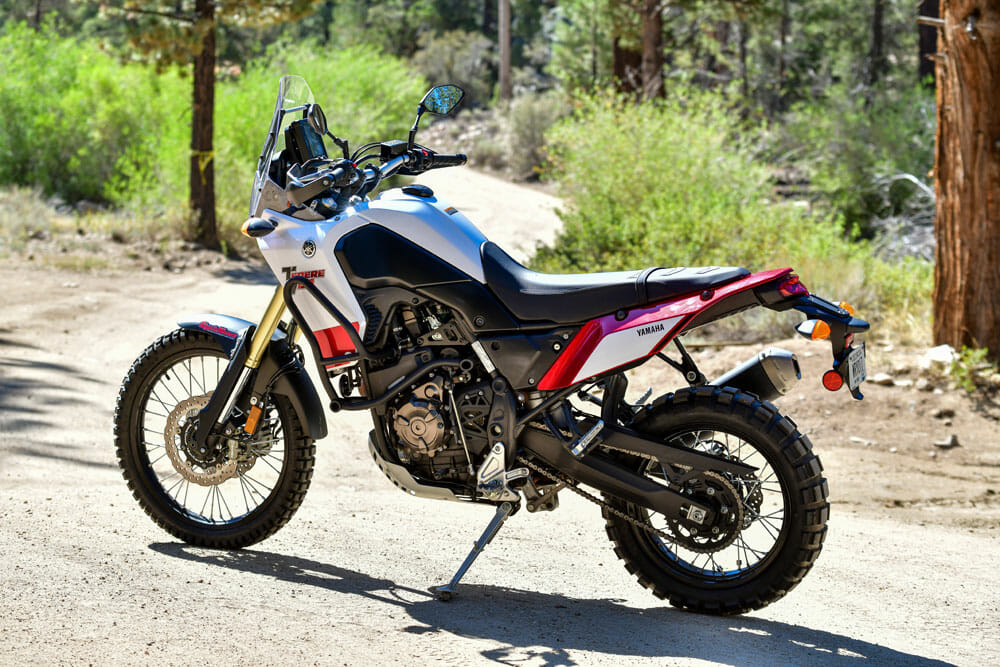
Yamaha Tenere 700 Specifications
| MSRP: |
$9,999 |
| Engine: |
Parallel Twin |
| Displacement: |
689cc |
| Bore x Stroke: |
80mm x 68.6mm |
| Valvetrain: |
DOHC, 8 Valves |
| Fueling: |
EFI |
| Horsepower (Claimed): |
72.4 hp at 9000 rpm |
| Torque (Claimed): |
50 lb-ft at 6500 rpm |
| Transmission: |
6-Speed |
| Clutch: |
Wet, Multi-Plate |
| Frame: |
Tubular Steel, Double Cradle, Single Unit |
| Handlebars: |
Tapered Aluminum |
| Front Suspension: |
KYB Coil Spring, Fully Adjustable |
| Rear Suspension: |
KYB, Single Shock, Linkage, Fully Adjustable |
| Front-Wheel Travel: |
8.3 in. |
| Rear-Wheel Travel: |
7.9 in. |
| Front Brake: |
Brembo, 4-Piston Calipers, Dual 282mm Discs w/ Selectable ABS |
| Rear Brake: |
Brembo, 2-Piston, 245mm Disc w/ Selectable ABS |
| Front Wheel / Tire: |
Spoked / 90/90R-21 in. Pirelli Scorpion Rally STR |
| Rear Wheel / Tire: |
Spoked / 50/70R-18 in. Pirelli Scorpion Rally STR |
| Rake: |
27.0° |
| Wheelbase: |
62.8 in. |
| Seat Height: |
34.6 in. |
| Fuel Capacity: |
4.2 gal. |
| Weight (Wet Weights, With Fuel): |
470 lbs. |